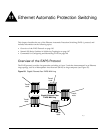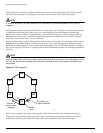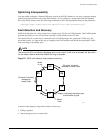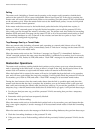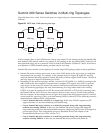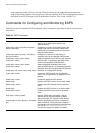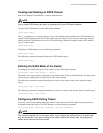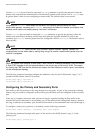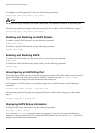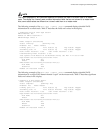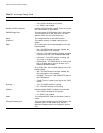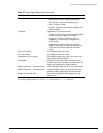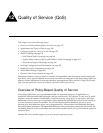
150 Summit 200 Series Switch Installation and User Guide
Ethernet Automatic Protection Switching
Use the hellotime keyword and its associated seconds parameter to specify the amount of time the
master node waits between transmissions of health-check packets on the control VLAN.
seconds must
be greater than 0 when you are configuring a master node. The default value is one second.
NOTE
Increasing the hellotime value keeps the processor from sending and processing too many
health-check packets. Increasing the
hellotime value should not affect the network convergence time,
because transit nodes are already sending “link down” notifications.
Use the failtime keyword and its associated seconds parameter to specify the amount of time the
master node waits before declaring a failed state and opens the logically blocked VLANs on the
secondary port.
seconds must be greater than the configured value for hellotime. The default value is
three seconds.
NOTE
Increasing the failtime value provides more protection against frequent “flapping” between the
complete state and the failed state by waiting long enough to receive a health-check packet when the
network is congested.
NOTE
When the master node declares a failed state, it also flushes its forwarding database (FDB) and sends
a “flush FDB” message to all the transit switches on the ring by way of the control VLAN. The reason
for flushing the FDB is so that the switches can relearn the new directions to reach Layer 2 end stations
via the reconfigured topology.
The following command examples configure the hellotime value for the EAPS domain “eaps_1” to 2
seconds and the failtime value to 10 seconds.
config eaps eaps_1 hellotime 2
config eaps eaps_1 failtime 10
Configuring the Primary and Secondary Ports
Each node on the ring connects to the ring through two ring ports. As part of the protection switching
scheme, one port must be configured as the primary port; the other must be configured as the secondary
port.
If the ring is complete, the master node prevents a loop by logically blocking all data traffic in the
transmit and receive directions on its secondary port. If the master node subsequently detects a break in
the ring, it unblocks its secondary port and allows data traffic to be transmitted and received through it.
To configure a node port as primary or secondary, use the following command:
config eaps <name> [primary | secondary] port <port number>
The following command example adds port 2 of the switch to the EAPS domain “eaps_1” as the
primary port.
config eaps eaps_1 primary port 2




